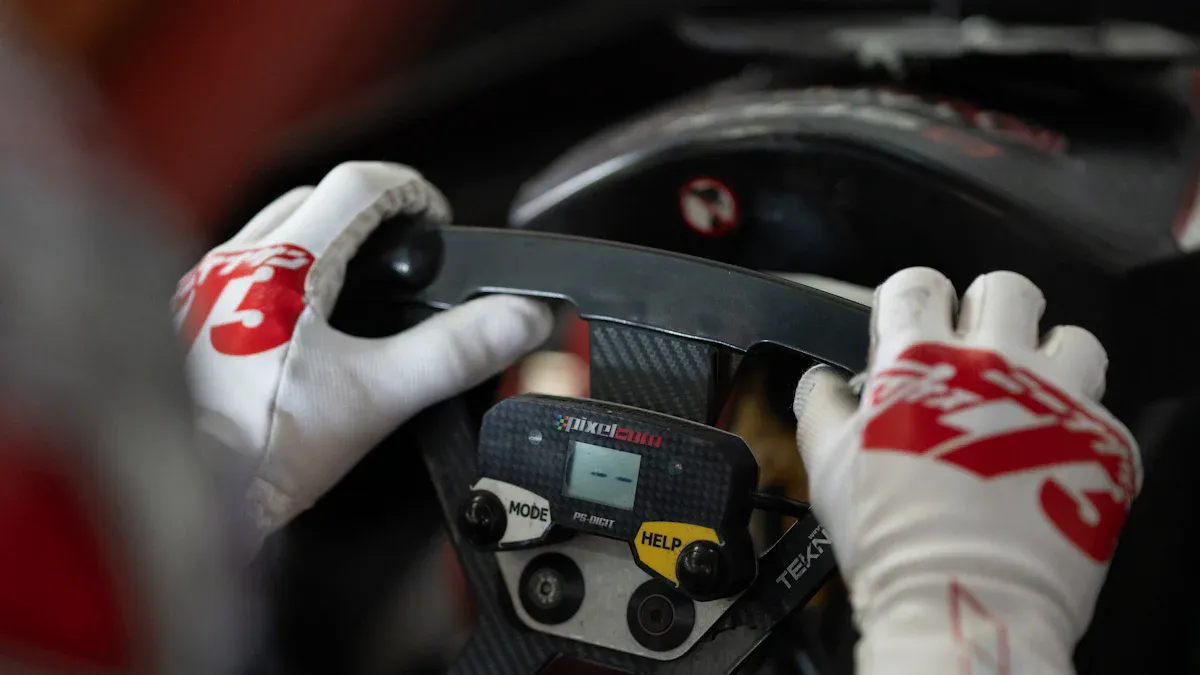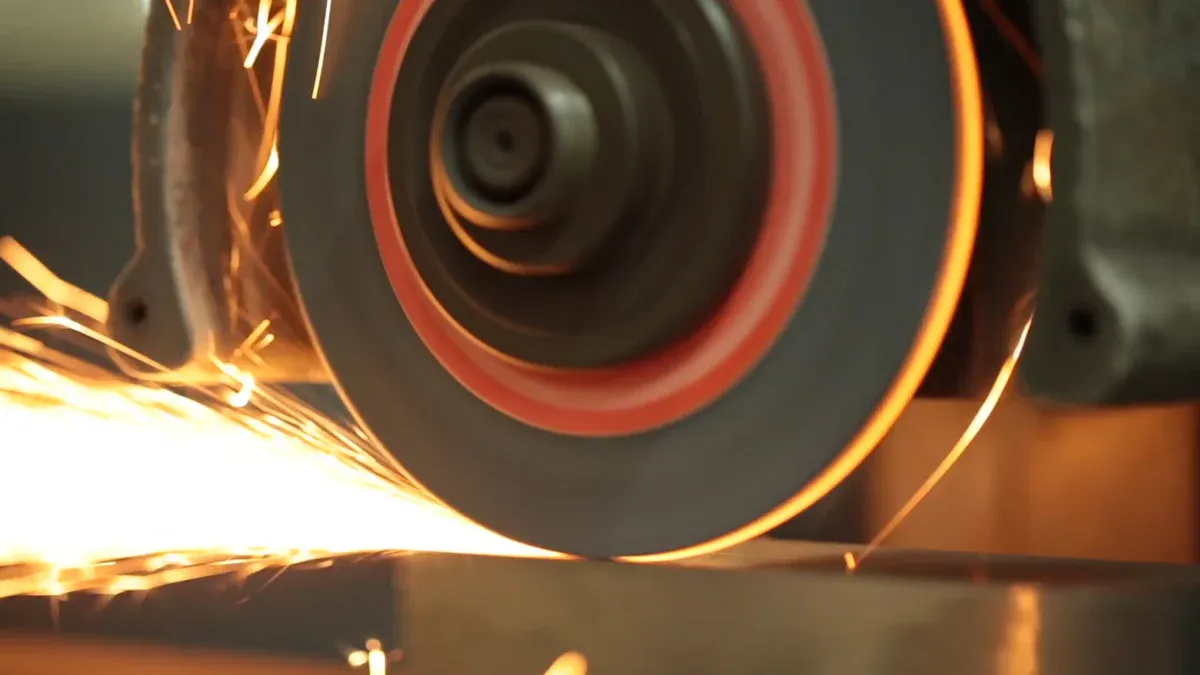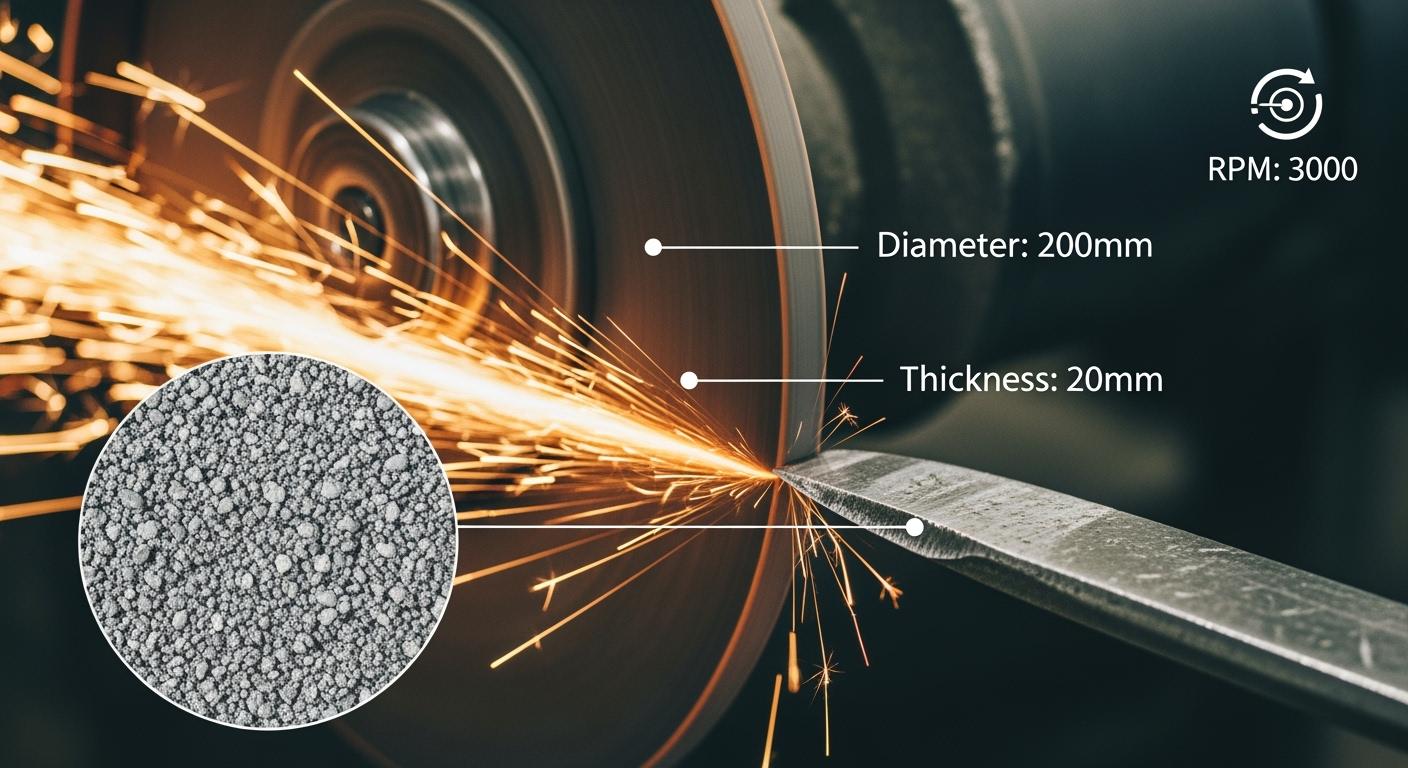The grinding wheel performance is defined by its specifications. These details explain the five principal characteristics of a grinding wheel. Every grinding wheel has a standard code printed on its label. This code acts like a recipe, detailing the wheel’s purpose for grinding.
Understanding the characteristic parameters of the grinding wheel is the first step. This knowledge helps answer the question: which grinding wheel should you choose? Proper selection is key for any grinding task. It helps you select the best grinding wheels, improving your grinding efficiency and results. The grinding wheel specifications reveal all of its important characteristics.
Key Takeaways
- Grinding wheels have five main features: abrasive material, grain size, wheel grade, structure, and bond type. These features work together to make the wheel cut well.
- The abrasive material does the cutting. Diamond and CBN are for very hard materials, while aluminum oxide and silicon carbide are for common metals.
- Grain size affects how fast material is removed and how smooth the surface becomes. Coarse grains remove material quickly but leave a rough finish. Fine grains create a smooth finish.
- Wheel grade shows how strong the glue is that holds the grains. A soft wheel lets dull grains go easily, showing new sharp ones. A hard wheel holds grains longer.
- The bond type is the glue that holds the abrasive grains. Different bonds like vitrified or resin are used for different jobs, affecting the wheel’s strength and how it cuts.
The Five Principal Characteristics of a Grinding Wheel

The performance of a grinding wheel depends on five key factors. These factors work together to determine how the wheel cuts, the finish it produces, and how long it lasts. Understanding these principal characteristics of a grinding wheel is essential for selecting the right tool. The main characteristics are the abrasive material, grain size, wheel grade, structure, and bond type.
1. Abrasive Material
The abrasive material performs the actual cutting work in a grinding operation. Different materials are suited for different jobs. The two main categories of materials used in grinding wheels are conventional abrasives and superhard abrasives.
- Conventional Abrasives are the most common. They include Aluminum Oxide and Silicon Carbide. Each has unique properties for specific applications.
| Feature | Silicon Carbide | Aluminum Oxide |
|---|---|---|
| Properties | Sharper and harder than aluminum oxide. | Softer and less sharp. |
| Applications | Best for grinding hard materials like ceramics, tungsten carbide, and steel. | Ideal for softer metals like aluminum and copper. |
| Durability | Very durable but can cause more wear on machinery. | Wears faster but is gentler on equipment. |
- Superhard Abrasives include Diamond and Cubic Boron Nitride (CBN). These are used for grinding extremely hard or brittle materials.
- They provide maximum precision for tough jobs.
- They offer a much longer wheel life than conventional types.
- They create smoother surface finishes.
- Diamond or CBN wheels are perfect for cutting materials like glass and ceramics or for grinding hardened steel.
2. Grain Size (Grit)
Grain size, or grit, refers to the size of the individual abrasive particles in the grinding wheel. This characteristic directly affects both the material removal rate and the final surface finish. Grit sizes are classified by industry standards.
Note: Two common systems are FEPA (Federation of European Producers of Abrasives) and ANSI (American National Standards Institute). Both use a number to indicate grit size. A lower number means a coarser grit, while a higher number indicates a finer grit.
The choice of grit size involves a trade-off between speed and finish quality.
| Grit Size Category | Material Removal Rate | Surface Finish Quality |
|---|---|---|
| Coarse | Rapid | Rough |
| Medium | Balanced | Good |
| Fine | Slower | Smooth, High-Quality |
Operators select a grit size based on the goal of the grinding task. Coarse grits are for rapid stock removal. Medium grits offer a balance for general-purpose grinding. Fine grits are necessary for achieving a high-quality, smooth finish. The surface finish is often measured by its Roughness Average (Ra). A finer grit produces a lower Ra value, meaning the surface is smoother.
3. Wheel Grade (Hardness)
The grade of a grinding wheel does not describe the hardness of the abrasive grains. Instead, it measures the strength of the bond holding the grains together. This is a critical characteristic. The grade is shown by a letter from A (soft) to Z (hard).
A softer grade wheel releases dull abrasive grains more easily. This exposes new, sharp grains. A harder grade wheel holds onto its grains for a longer time.
Several factors help determine the correct grade for a job:
- The material being ground
- The amount of grinding pressure
- The required surface finish
- The area of contact between the wheel and workpiece
- The speed of the wheel
- The use of coolant
Tip: A general rule is to use a soft grade wheel for hard materials and a hard grade wheel for soft materials. Using a soft grade can also reduce heat during grinding, which helps prevent thermal damage to the workpiece.
4. Structure (Grain Spacing)
The structure of a grinding wheel refers to the spacing between the abrasive grains. This is measured on a scale from 1 (most dense) to 17 (most open). The structure number indicates the ratio of abrasive and bond to the air space in the wheel. This spacing affects chip clearance and coolant flow.
- Dense Structure (Low Numbers): These wheels have grains that are packed closely together. They are good for precision grinding and creating fine finishes. A dense wheel holds its shape well but can generate more heat.
- Open Structure (High Numbers): These wheels have more space between the grains. This allows for better chip removal and coolant flow, making them ideal for heavy stock removal and grinding heat-sensitive materials. They cut more freely but may wear faster.
Choosing the right structure helps balance cutting efficiency with the desired finish.
5. Bond Type
The wheel bond is the adhesive that holds the abrasive grains together. The bond type is a crucial element that influences the grinding wheel’s strength, flexibility, and maximum operating speed. There are many types of bonds, each designed for different applications. The bond is one of the most important characteristics of the grinding wheel.
Here are some of the most common bond types:
| Bond Type | Key Properties |
|---|---|
| Vitrified (V) | A hard, strong, and porous bond made from fired clay. It is rigid and not affected by water or oil. It is the most common bond for precision grinding. |
| Resin (B) | An elastic bond that provides a smoother, cooler cutting action. It is excellent for high-speed grinding and cutting-off operations. |
| Metal (M) | A very strong and durable bond. It offers exceptional abrasive retention and long wheel life, making it ideal for grinding very hard materials with superabrasives. |
| Rubber (R) | A flexible and resilient bond. It is used for applications requiring a very fine finish and for producing a smooth, chatter-free cut. |
The bond type is a key factor in all types of grinding wheels, from heavy-duty grinding to fine polishing.
Abrasive Material Characteristics
The abrasive material is the heart of the grinding wheel, as it performs the cutting. The choice of material directly impacts the grinding performance and the types of jobs a wheel can handle. The materials used in grinding wheels fall into two main categories: conventional and superhard abrasives.
Conventional Abrasives
Conventional abrasives are the most common types used in many grinding applications. The two primary types are Aluminum Oxide and Silicon Carbide. Each has distinct properties.
- Aluminum Oxide: This abrasive is suitable for grinding materials with high tensile strength. Grinding wheels with aluminum oxide are excellent for applications involving stainless steel, aluminum alloys, and high-tensile bronze.
- Silicon Carbide: This material is harder and sharper than aluminum oxide. Operators use it for grinding low-tensile strength or non-metallic materials. Its applications include grinding cast iron, ceramics, glass, and plastic.
Superhard Abrasives: Diamond and CBN
For the most challenging grinding tasks, superhard abrasives provide unmatched performance. These advanced types of grinding wheels are essential for working with extremely hard or brittle materials.
Diamond is ideal for grinding hard and fragile substrates like ceramics, tungsten carbide, and composites. Cubic Boron Nitride (CBN) excels in grinding hardened steels. These abrasives offer a longer tool life and create a higher quality surface finish, which lowers the total cost of ownership in high-value industries.
Aimgrind‘s expertise in providing customized solutions shines here. Their diamond grinding wheels are engineered for superior performance and longevity in demanding industries.
Matching Abrasives to Materials
Selecting the correct abrasive is a key characteristic of an effective grinding process. The right match ensures efficiency and prevents damage to both the grinding wheel and the workpiece. A general rule is to use a softer abrasive for hard materials and a harder abrasive for softer materials to prevent wheel loading.
This principle guides many industrial applications of grinding wheel selection:
- Mild Steel: General-purpose aluminum oxide wheels are effective.
- Cast Iron: Silicon carbide wheels are the best choice due to the material’s brittle nature.
- Hardened Steel: A precision grinding wheel with CBN is necessary for sharpening and finishing.
- Aluminum: A softer grade aluminum oxide wheel with a coarse grit prevents the wheel from clogging.
Understanding Grinding Wheel Specifications

Every grinding wheel has a code printed on its label. This code is not random. It is a standard marking system that reveals the tool’s key characteristics. Understanding this code helps users read the grinding wheel specifications. These specifications guide the selection of the right tool for any grinding job. The code provides a complete recipe for the wheel’s performance.
Decoding the Standard Marking System
The standard marking system uses a sequence of letters and numbers. Each position in the code represents one of the five principal parameters. This system makes it easy to identify the features of different types of grinding wheels. Learning to decode these specifications is essential for proper grinding wheel selection and safe operation. The full grinding wheel specifications are detailed in this sequence.
Grain Size Specifications
The grain size, or grit, is shown as a number in the specifications.
- Coarse Grits (e.g., 16, 24): These are for fast material removal.
- Medium Grits (e.g., 46, 60): These offer a balance for general grinding.
- Fine Grits (e.g., 100, 120): These are for finishing and precision grinding.
The number helps operators choose the right wheel for their desired surface finish. Different types of grinding tasks require specific grit sizes.
Grade and Structure Specifications
A letter from A (soft) to Z (hard) indicates the wheel’s grade. The grade describes the bond’s strength. A number from 1 (dense) to 17 (open) shows the structure, or grain spacing. These two specifications are critical for matching the grinding wheel to the material and grinding process. The various types of grinding wheels have unique grade and structure combinations for optimal performance.
Bond Type Codes
A letter code identifies the bond material holding the abrasive grains. The bond is one of the most important types of specifications. It affects the wheel’s strength and grinding action. The grinding wheel specifications clearly state the bond type. Common bond types have standard codes.
Tip: The bond code is a key piece of information. It tells you how the wheel will behave under pressure and speed.
| Bond Type | Standard Code |
|---|---|
| Vitrified | V |
| Resinoid | B |
| Rubber | R |
Other bond types, like Metal (M) and Electroplated (E), also have their own codes. These codes help users quickly identify the wheel’s intended use.
Grinding Wheel Grade and Bond
The grade and bond are vital characteristics of a grinding wheel. They work together to control how the wheel performs during a grinding operation. The grade defines the bond’s strength, while the bond type provides the fundamental properties for different types of grinding.
Defining Wheel Grade vs. Abrasive Hardness
It is important to understand the difference between wheel grade and abrasive hardness. The grade does not measure the hardness of the abrasive grains. Instead, the grade measures the strength of the wheel bond holding the grains. The amount of adhesive, or bond, determines the grade. A stronger bond holds abrasive grains more tightly. This allows the grinding wheel to handle greater stress during grinding. A weaker bond lets the grains release more easily.
The A-Z Hardness Scale
The hardness scale for a grinding wheel uses letters from A to Z. ‘A’ represents the softest grade, and ‘Z’ represents the hardest. As you move further along the alphabet, the wheel becomes harder. This grade affects many grinding factors, including wheel speed and feed rates.
For example, a letter like ‘I’ is often a good general-purpose hardness for tool room grinding.
The scale is typically grouped into three main types of hardness ranges.
| Grade Range | Hardness Level |
|---|---|
| A to H | Soft |
| I to P | Moderately Hard |
| Q to Z | Hard |
Key Bond Type Characteristics
The bond type and grade determine the best use for a grinding wheel. Different types of grinding jobs require specific wheel properties. Softer wheels are good for cool grinding and working with harder materials. Harder wheels offer a longer life and are suitable for softer materials. The choice depends on the specific grinding application.
| Wheel Grade | Characteristics | Applications |
|---|---|---|
| Soft Grade | Releases abrasive grains easily, preventing heat buildup. | Used for hard materials, large contact areas, and high stock removal. |
| Hard Grade | Retains abrasive grains longer, providing a longer wheel life. | Used for soft materials, small contact areas, and maintaining form. |
Choosing the correct combination of bond and grade is essential for efficient grinding and achieving the desired results for all types of applications.
The five characteristics of a grinding wheel—abrasive, grain size, grade, structure, and bond—define its performance. The code on every grinding wheel reveals its specifications. This knowledge helps answer: which grinding wheel should you choose? For complex industrial applications of grinding wheel, customized solutions improve performance. Specialized suppliers like Aimgrind help optimize grinding applications, enhancing productivity and quality in all grinding tasks. Understanding these grinding wheel specifications is key for successful grinding.
FAQ
How do you choose the right wheel for a grinding job?
Operators select a wheel by matching its five parameters to the job. The workpiece material, desired finish, and type of grinding operation determine the best choice. Proper selection is vital for an efficient grinding process and successful applications. Successful grinding depends on the right tool.
What is the most important parameter for grinding hard materials?
The abrasive is the most critical factor for hard material grinding. The materials used in grinding wheels, like diamond or CBN, are essential. These superhard abrasives excel at grinding tough materials. Conventional abrasives are better for softer metals. Successful grinding requires the correct abrasive.
Does a harder wheel grade mean better grinding?
Not always. A harder grade wheel is best for grinding soft materials. A softer grade wheel works better for grinding hard materials. It releases dull grains to expose sharp ones, which improves the grinding action and surface quality. The grade directly impacts the grinding performance.
Why are there different types of grinding wheels?
Different types of grinding wheels exist for specific applications. A precision grinding wheel has different properties than one for rough grinding. The various combinations of abrasive, grade, and bond create many types of wheels. Each is engineered for a unique purpose in grinding.
See Also
Exploring Diverse Grinding Wheel Varieties and Their Real-World Uses
Selecting Optimal Bench Grinding Wheel Materials Tailored to Your Requirements
Discovering the Most Effective Grinding Wheel Dresser for Your Specific Tasks
Selecting the Ideal Grinding Wheel for Precision Carbide Tool Sharpening
Guidance on Choosing the Perfect Grinding Wheel for Stainless Steel Fabrication
Contact Us
For More Grinding Solution or Customized Abrasive Tools

